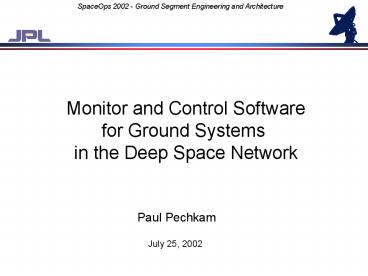Monitor and Control Software - PowerPoint PPT Presentation
1 / 15
Title:
Monitor and Control Software
Description:
Describe the requirements for monitor and control in NASA's Deep Space Network ... Introduce Network Monitor and Control (NMC) software and its components ... – PowerPoint PPT presentation
Number of Views:160
Avg rating:3.0/5.0
Title: Monitor and Control Software
1
Monitor and Control Software for Ground Systems
in the Deep Space Network
Paul Pechkam
July 25, 2002
2
Introduction
- Objectives
- Describe the requirements for monitor and control
in NASAs Deep Space Network - Introduce Network Monitor and Control (NMC)
software and its components - Focus on infrastructure
- design concepts used
- infrastructure components
- some lessons learned
- What is infrastructure?
- Underlying software/hardware foundation of a
monitor and control system
3
Deep Space Network
- The Deep Space Network (DSN)
- international network of spacecraft tracking
complexes - Each complex is a self contained site of
operations - pool of antennas simultaneous tracking (limited
to number of antennas) of multiple spacecraft - shared ground equipment including transmitters,
receivers, telemetry processors, etc. - complex-to-complex hand-over for continuous
tracking of a single spacecraft - Remote monitoring
- monitoring of complex activity available at the
Network Operations Control Center at Jet
Propulsion Laboratory
4
Deep Space Network (cont.)
- Operations - typical duties (some are automated)
include - allocating equipment from a pool of resources for
a track - configuring equipment
- monitoring equipment during track via graphical
displays or access to raw monitor data - post-track cleanup (stowing the antenna,
packaging spacecraft data) - releasing equipment for next support
- Operations require an interface to equipment with
the ability to control - Operations require access to monitor data and
event messages produced by equipment for
monitoring status and health
5
Infrastructure Requirements
- Why infrastructure is important
- Increasing number of spacecraft supports and
limited resources require reliable operations
24/7/365 - New spacecraft and/or new technologies promote
new types of ground equipment that need to be
integrated - Additional load equals more data processed and
flowing - Accessibility and visibility to all ground
equipment is required for monitor and control in
any form of automation. Data examples include - equipment health
- signal health as reported by telemetry or signal
receivers - Different tracking configurations such as antenna
arraying and/or multiple spacecraft per antenna
require increased communication between equipment
and feedback back to operations and automation
6
Building Infrastructure
- Network Monitor and Control (NMC) software uses a
network architecture of servers and user
workstations - Good infrastructure will provide
- manageability
- reliability
- performance
- scalability
- interoperability
- security (if needed)
- Hardware
- off-the-shelf network hardware including switches
and routers to interconnect Sun servers and
workstations and establish communication with
ground equipment
7
Infrastructure (cont.)
- Service oriented
- Name services - provide a means for clients to
reach other clients - Functional name services - allow for data
representation via formatted names - Monitor data services - provide for monitor data
accessibility - Messaging services - provide a means for clients
to send/receive messages to/from other clients - Event Notification services - provide event
notification and the ability to trigger responses
according to specific events - Control services - provide a means for sending
and receiving commands with proper format - Connection services allocating and managing
resources for an antenna
8
Infrastructure (cont.)
- Client-server methodology
- Ground equipment are represented as clients data
recipients (displays, automation software) are
also represented as clients - Transaction based processing
- reliable processing of request
- Data flow control
- publish/subscribe methodology for monitor data
and events - data is only sent on a network if subscribed to
- allows for procedures to be triggered on the
client when subscribed data is received - advanced queue processing
- prevents backlogging of data
9
Infrastructure (cont.)
- Base software components
- Name Server
- Monitor Data Server
- Client library and Application Programming
Interface (API) - contain client-server and client-client protocols
- Shared file system - based on NFS
- Additional components for managing ground
equipment - Connection engine/server(s) - a server process
representing an antenna and its
configured/assigned equipment. - Translator - a server process used to translate
legacy protocols - User Interface - suite of graphical displays for
real-time monitoring and control of assigned
equipment
10
NMC in a Deep Space Communications Complex
Ground Equipment
Display
ALERT!
NMC Workstation
ALERT!
NMC Filesystem (NFS)
NMC Servers
(Name Server, Monitor Data Server, Connection
Engines, Translator)
11
Distributed NMCs in the Deep Space Network
Goldstone Deep Space Communications Complex
Madrid Deep Space Communications Complex
Network Operations Control Center (JPL)
Canberra Deep Space Communications Complex
12
Achieving Performance
- Server optimizations
- Thread-based for parallel access to services and
data - Identify and discard stale data
- Client optimizations
- Thread-based to allow for parallel event-driven
applications - Use existing protocols and accepted standards
- compatibility and portability
- POSIX
- TCP/IP as a reliable protocol
13
Performance (cont.)
- Obtaining scalability
- server processes are network processes and can
run on one host or distributed on many hosts - Obtaining reliability
- fail-over capability
- client-side caching
- server pools
14
Lessons Learned
- Plan for performance measuring and analysis
- Protect servers from non-nominal client activity
- The network is limited resource
- Avoid inefficient thread models
- A Wide Area Network (WAN) is not as reliable as a
Local Area Network (LAN) - Avoid server dependencies on shared resources
e.g. shared filesystem
15
Conclusion
- Software and hardware infrastructure is an
important part of ground communications (in the
DSN) - Allow operations to worry about the spacecraft
only - Ready for new equipment and/or operational
scenarios - Automation relies on data availability and
feedback from equipment - Automation can better predict the environment
with increased data access and evaluate decisive
action - Numerous applications beyond spacecraft tracking
- NMC is operational and supporting live spacecraft
tracking































